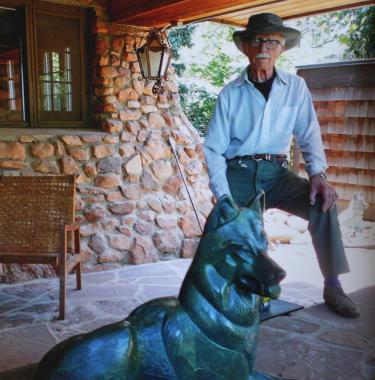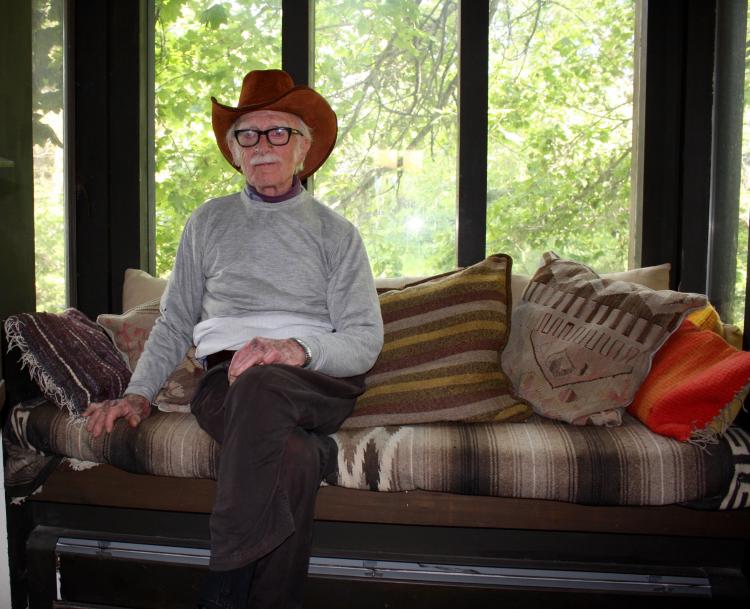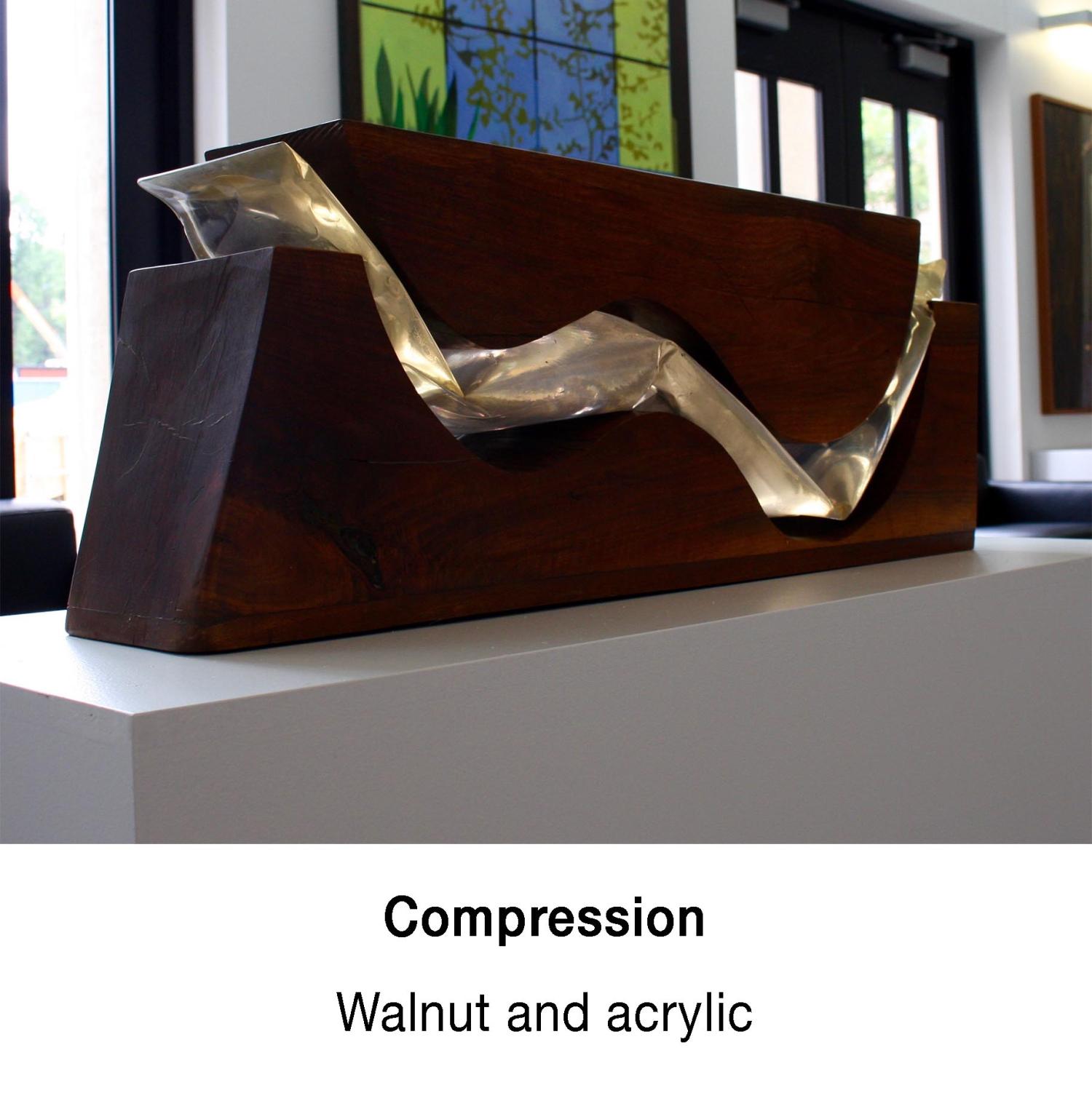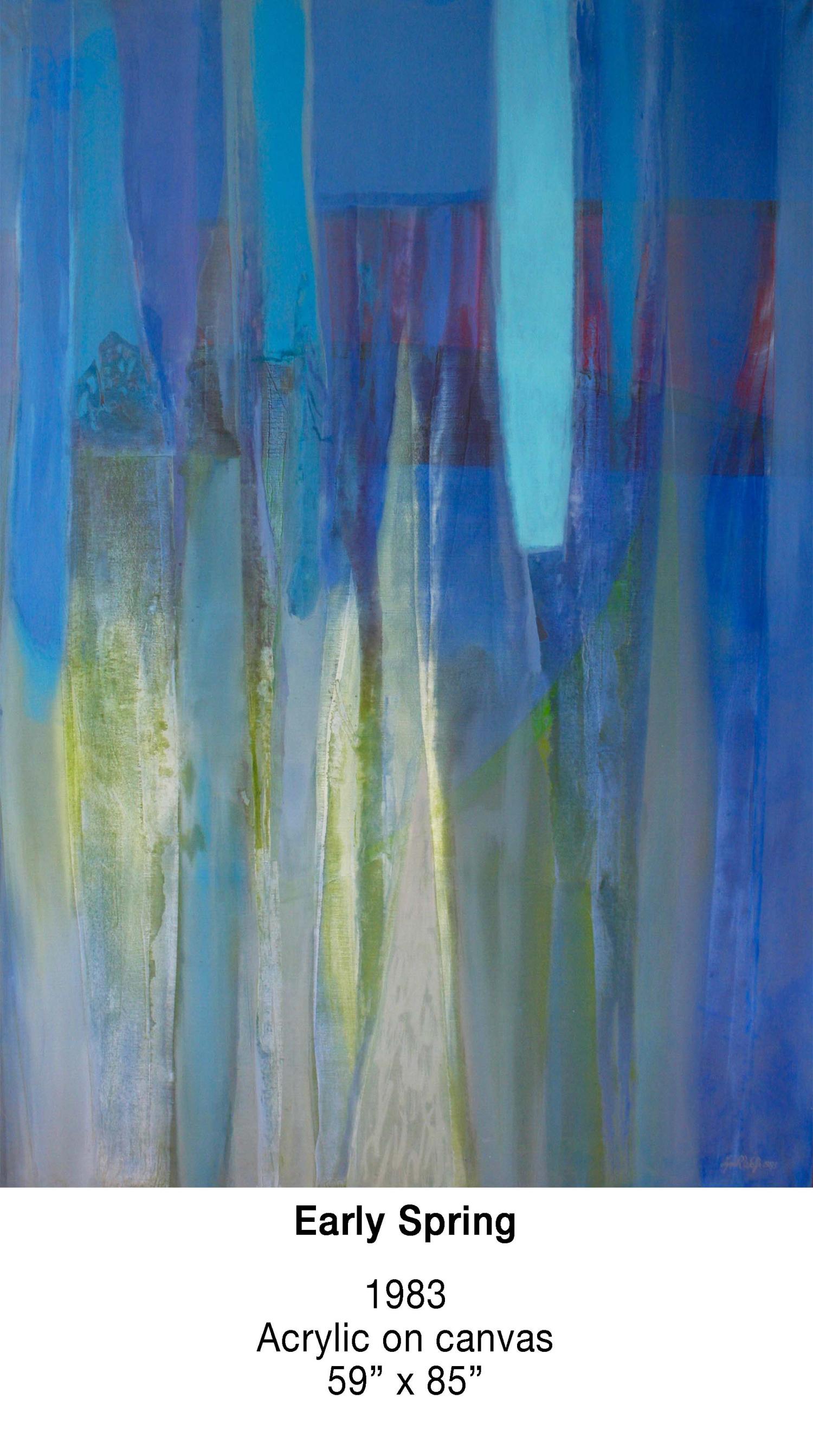Art and Art History Department celebrates the life, work and hundredth birthday of one of its formative faculty members; exhibition of Lynn R. Wolfe’s work runs from July 7 to Aug. 31
Lynn R. Wolfe was born just after the start of World War I, served in the Army during World War II, retired when Ronald Reagan was in the first year of his presidency and now spends his days creating new art.
Wolfe, professor emeritus of art and art history, served the University of Colorado Boulder for 36 years before his retirement, and he will turn 100 years old this September. To celebrate Wolfe's contribution to the college, the Department of Art and Art History will stage an exhibition of his vast creative output from July 7 to Aug. 31 at the Visual Arts Complex on Campus.

One of Wolfe's most cherished pieces is a bronze wolf resting beside his wife’s grave in Red Cloud, Nebraska. (Photo from Wolfe family)
The celebration heralds a man who never applied for a job, describes himself as the worst soldier in World War II, and says his wife's good looks got him a fellowship at CU Boulder. As he tells it, he has always enjoyed the irrepressible force of luck.
As an artist, Wolfe describes himself as "a watercolorist" first, sculptor second and then a stained-glass artist, though his work spans a multitude of mediums, utilizing countless materials, including oil, ink, bronze, clay, mosaic tiling, wax, ironwood, textiles, a unique combination of walnut and acrylic and nearly every other source and surface imaginable.
His art, which is subtly dispersed throughout Colorado and elsewhere, is influenced by the American west and southwest landscapes. Wolfe has stained-glass windows featured both at a Presbyterian hospital in Denver and at St. Aidan's Church in Boulder; a pair of doors in repoussé copper gracing the Danforth Chapel in Fort Collins; a Mexican-glass mosaic decorating the First Congressional Church in Boulder; and a doorway design in tile standing in a church in Durango.
His work has been reproduced in Marjorie Bevlin's Design Through Discovery and written about favorably by New Yorker magazine, in 1951.
Most cherished to Wolfe, perhaps, is a bronze wolf resting beside his wife’s grave in Red Cloud, Nebraska. A similar sculpture lies in the Steamboat Springs Botanic Garden (1998) as a tribute to his daughter.
Seated at his dining room table, Wolfe spoke cheerfully and with a rhythmic, natural voice for storytelling. He said he’d like to share some remarks before answering questions, and with that, he began, unprompted and without pause:
He was born on Sept. 11, 1917, in Red Cloud and grew up on a dairy farm his grandfather built in 1872.
"My mother went down a list of WWI soldiers to find a name that started with L, because my older brother’s name was Laird. So, she found Lynn. Well, Lynn is a girl’s name," said Wolfe, "and if you’re the smallest boy in the classroom you can't possibly have that as a name. So, my middle name is Robert, and I was all-American Bob until 1939."

Lynn Wolfe met his wife Arlene in 1939, and was immediately smitten (Photo from Wolfe family).
That year, he went to a sock hop and saw "this gorgeous strawberry blonde across the dance floor." He asked her to dance, and she asked his name.
"I said, 'Bob. Bob Wolfe.' And she said, 'Don’t you have another name?' So, I said, 'Well my first name is Lynn.' And she said, 'Well I'll call you Lynn. And I've been Lynn Wolfe ever since."
That young woman was Arlene, about whom Wolfe seems as smitten with today as he was nearly 80 years ago. When speaking of her, he never fails to describe her as "beautiful."
Wolfe said he was an artist first, since the age of 6, but he taught school for a living. It was a career, he implied, that chose him, but which he performed with dedication and joy, like his artwork.
Typical artist biographies allude to a childhood trauma or parental misunderstanding, but Wolfe's family had always been very supportive. His grandfather taught him to read before he started kindergarten. Later, he was high school valedictorian and attended the University of Nebraska on a scholarship.
After he'd graduated from college, he was spending an afternoon painting landscapes by the Republican River in Nebraska. His portable radio broke the news that Pearl Harbor had been attacked.
"And I thought to myself, 'Oh hell. There goes my youth,' and I knew I was going to be drafted."
Wolfe served two-and-a-half years in World War II as an Army photo intelligence officer, stationed in Australia, New Guinea and New Britain. After he was discharged, he married Arlene.
Wolfe suggests he has always been at the right place at the right time, including during his ascendance through the ranks from Army private to captain, despite being "the worst soldier in World War II."
"I've never applied for a job," he said. "I'm not even sure how you do it."
Later, the Wolfes lived in Paris with their daughter, where he studied with Ossip Zadkine, the renowned Russian Cubist, and still later, they traveled the world together. He had already taught photointerpretation for the army in Florida, then art at the University of Nebraska, later CU, and the Universities of Hawaii and Alaska before finally returning to Boulder, where he was first hired to teach after being approached by Muriel Sibell-Wolle, chair of the art department, and soon after he received his MFA from CU in 1948.
While in Nebraska, he sent a photo of his wife and him, in uniform, to CU Boulder. "And I knew when they saw how attractive she was, I'd get a fellowship, which I did."

Lynn Wolfe began his career at CU Boulder in 1945, and soon after received his MFA (Photo by Craig Levinsky).
He was a student here when Muriel Sibell-Wolle, who was head of the art department, asked him to teach for the department. He pointed out that he didn’t have an advanced degree, and she told him he could finish his degree while teaching.
"So, again, I didn’t apply for that job either. They just offered it to me."
One evening in 1951, Lynn and Arlene invited some friends over to the house. Arlene had been thinking about the public parks she enjoyed with their daughter in Paris, the likes of which they didn’t quite have in Boulder. After much discussion, the Wolfes and their guests, including the late Al Bartlett, a professor of physics, formed PLAN-Boulder (People's League for Action Now), an organization that charged itself with ensuring that Boulder County preserved much of its open spaces, that very night. PLAN-Boulder still exists, working to support and protect a number of local social and environmental causes.
Further supporting open space, the Wolfes made a sizable donation to CU, which will partially be used soon to develop a garden path in the area of Macky Auditorium, called the Wolfe Garden Walk.
Looking back on life, Wolfe said, he recalls the happiest times being when he assumed the role of "protector" with young children.
"I'm not a very daring person, but when I had the family to protect, I could have died saving them from something," he said. "And I think that's the time I found most exciting."
In the realm of teaching, "I find that working with young people keeps you young. I found the students so much fun to work with. I’ve felt lucky ever since I came here as a student, and I felt lucky ever since I became a teacher here."
"I feel sorry for people who retire and don't have anything to do. I turn on the television to see how bad the roads are. Then I turn it off and go right downstairs to my studio and get to work. In other words, it beckons. I don't need drugs. I'm on a high all the time. And it's because of the relationship I have with my work. I could fight the battle forever."










